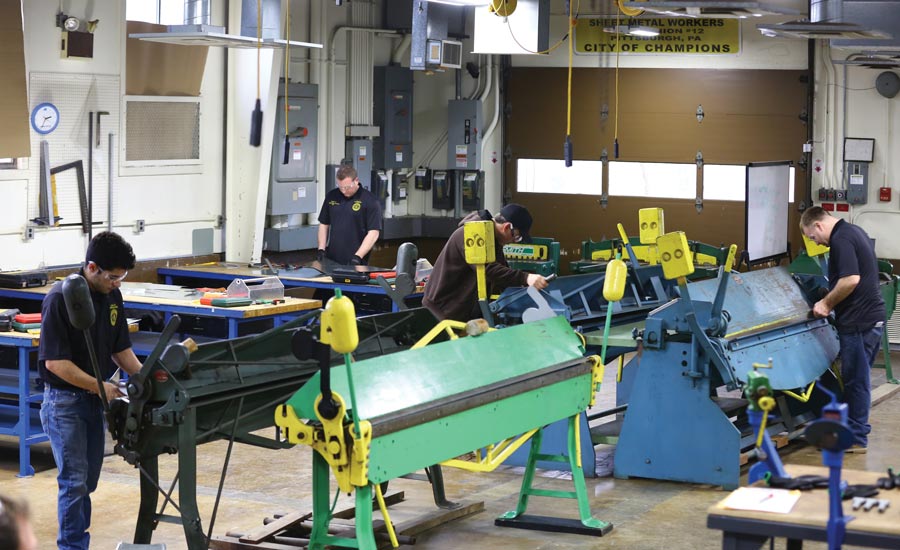Sheet metal, like all trades, faces a major staffing challenge. The Sheet Metal & Air Conditioning Contractors’ National Association (SMACNA) forecasts that 35% of the workforce will retire in the next five years. So how does the industry attract new workers to this crucial field? By presenting it as a stable, but not stagnant, occupation.
Butch Welsch, owner of Welsch Heating & Cooling in St. Louis, said he has a relatively easy time attracting workers. His local chapter of sheet metal union SMART regularly receives hundreds of applications for its apprentice program. St. Louis has a long history as a working-class city. But Welsch understands the challenges others face.
He said the field offers many selling points to young people. One of the most important is good-paying jobs with steady work — and, more importantly to many, without student debt.
Sheet metal is a field with a long past and a bright future. Welsch said those looking for a job using technology find sheet metal provides just that. For example, his shop uses a computer-operated layout table. Years ago, this job was done by hand, with someone drawing in where each little notch needed to be placed.
Sheet metal work provides daily satisfaction, Welsch said. His workers drive past the houses they work on every day. Twice a month, the local SMART chapter puts out a newsletter featuring especially impressive projects. One of the latest was a steeple at a local shrine.
“You accomplish something when the day is done, but you have to be willing to work to do it,” Welsch said.
SMACNA Spreads the Word
SMACNA is working to spread the word about these opportunities to young people. Jeff Henriksen, executive director of communications at SMACNA, said the association views this as an opportunity rather than a challenge.

CUTTING EDGE: Sheet metal is a stable field, but the way the work gets done is ever-changing, incorporating the latest technology, including robotics.
“Sheet metal is one of the least known trades compared to carpenters or electricians, but we are one of the highest-salaried trades, so we have to raise awareness of both the trade and the benefits we bring to the table,” Henriksen said.
To improve awareness, SMACNA recently launched Ignite Your Career. This comprehensive industry-focused marketing plan includes a website, advertising campaigns, social media engagement, and strategic partnerships. The website has a handful of resources for those already in the business to highlight cool project case studies as well as personal stories and testimonials from the field. This gives young people a chance to hear from real workers who have loved their experience in the sheet metal industry.
In addition to Ignite Your Career, SMACNA is also collaborating with career and technical education programs, as well as partnering with the National Association of Workforce Boards to align on recruitment opportunities.
SMACNA is also encouraging its member companies to embrace diversity and inclusion as an integral part of the growth and success of the industry. The association launched the Women in Construction Leadership Council, working with local chapters on diversity roundtables and collaborating with National Association of Workforce Boards to expand and diversify the workforce, Henriksen said.
Future Field Leaders for Sheet Metal
Of course, a job is one thing. What many people want is the opportunity for career advancement. This is another area of great opportunity for the sheet metal business. Not only are workers aging out of the field at a fast rate, but leaders are aging out even more quickly. Ryan Quigley, a consultant with FMI Consulting, spoke on this topic at this year’s SMACNA conference. Field leaders play a crucial role for the sheet metal business, Quigley said. They are the main point of contact for customers.

ART AND SCIENCE: Sheet metal workers create projects that look good as well as function properly.
“This is where your company reputation is at stake, your project performance is at stake,” Quigley said. “And a lot of the revenue drivers are really at stake with your field leaders.”
He shared data from a survey of 178 respondents at 74 different companies. The respondents represented a range of roles. The survey found the companies that saw the most seamless transitions into field leader roles had an intentional process for identifying, recruiting, developing, and retaining their talent.
Quigley said companies that really spent time and developed their field leaders gained loyal employees. This proves essential for getting the most out of a company’s efforts to develop field leaders.
“Obviously, if you’re going to spend all the dollars and the time on developing this talent, you need to have a plan on how you’re going to retain them long term, and that’s how you’re going to get the return on your investment,” he said.
Lessons Learned
The challenge for sheet metal companies is how to develop field leaders while also completing complicated tasks on deadline. Quigley said each organization is unique and managers need to find the best method for developing field leaders at that specific company. That method needs to be very specific and based around the company’s core values.
“We can give you a number of competencies that we heard for most field leadership,” Quigley said. “But it has to be unique to you, the way that you do work, and the way that you execute work.”
Quigley said spotting potential field leaders must be part of the hiring process — or even before that. He said many companies he works with find great success with internship programs.
“It’s a very low-risk, potentially high-reward opportunity to get your eyes on some young talent early on in their careers,” he said.
Quigley has found that field leaders share some key traits. One is they are good communicators. Another is they have the ability to maintain and build relationships — and the ability to influence people through those relationships. Field leaders also need strong organization and planning skills. Finally, they must be inquisitive.
“It’s about assessing your talent against these competencies,” Quigley said.
Once a company has identified people with those competencies, it is time to share a vision of a possible future with these employees. Then development starts. This includes having field leader candidates working on all the different types of projects a company undertakes. It also means having them take on different roles at those projects to see them from all angles, Quigley said. They should also work under different leaders and see how they handle different situations.
When a project ends, management should consider having a leadership candidate write out a “lessons learned” report, Quigley said. This helps both the company and the field leader learn about a project and ways to improve. It also helps future leaders develop presentation skills.
Finally, once someone gets promoted to field leader, companies need to avoid a sink-or-swim approach. Mentoring these leaders is vital to ensure they succeed.








